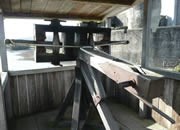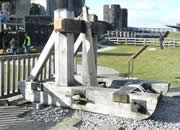In the early part of the medieval period battles were mostly fought in the style of attack and defence. The enemy would attack a castle and its inhabitants would defend it from the inside. Rarely did the two sides meet in open battle. This was because up until the introduction of cannons and gunpowder in the 14th century it was almost impossible to destroy a castle completely, so it was safer for those being attacked to shelter behind its thick, strong walls.
The attackers found many different ways to try and force the defenders of a castle to surrender. The first was to use siege engines to attack the castle. There were several different types of siege engines, designed to get missiles over the tall castle walls or cause as much damage as possible. One method was to build a siege tower or "belfry". This was a quickly-constructed tower of wood that could be wheeled up to the castle walls, which would then allow the attackers to fire arrows and other missiles over the walls and onto the castle defenders.
 Other ways of attacking involved machines (known collectively as siege engines) that hurled missiles at the castle. These siege engines took three forms: the ballista (a kind of large crossbow), counterpoise machines (the trebuchetand the perrier), and the mangonel (a giant catapult). The ballista used the torsion method of propulsion. It was mounted on a wooden stand, and its arms were fastened to twisted ropes. The bowstring was then cranked back, and the increasing pressure put the ropes under strain. When the pressure had reached the right level, a release mechanism shot the missile towards its target. The ballista had a considerable range.
Other ways of attacking involved machines (known collectively as siege engines) that hurled missiles at the castle. These siege engines took three forms: the ballista (a kind of large crossbow), counterpoise machines (the trebuchetand the perrier), and the mangonel (a giant catapult). The ballista used the torsion method of propulsion. It was mounted on a wooden stand, and its arms were fastened to twisted ropes. The bowstring was then cranked back, and the increasing pressure put the ropes under strain. When the pressure had reached the right level, a release mechanism shot the missile towards its target. The ballista had a considerable range.
 The perrier was the smaller of the counterpoise machines. It had a launching arm which pivoted on a bar, resembling a seesaw. To operate the perrier, a team of men pulled down on ropes fastened to one end. At the other end was a sling containing the missile. The missile's weight was affected by the force exerted by the men pulling on the rope, and when the rope was released the launching arm was levered forwards with great force, hurling the missile at speed. The perrier was relatively quick and easy to re-set and fire again. The trebuchet, on the other hand, was larger, heavier and slower to re-set. The downforce on its lever was provided by a ballast-filled box rather than a team of men, and it fired large rocks. The trebuchet's huge size and range made it the most effective of the siege engines.
The perrier was the smaller of the counterpoise machines. It had a launching arm which pivoted on a bar, resembling a seesaw. To operate the perrier, a team of men pulled down on ropes fastened to one end. At the other end was a sling containing the missile. The missile's weight was affected by the force exerted by the men pulling on the rope, and when the rope was released the launching arm was levered forwards with great force, hurling the missile at speed. The perrier was relatively quick and easy to re-set and fire again. The trebuchet, on the other hand, was larger, heavier and slower to re-set. The downforce on its lever was provided by a ballast-filled box rather than a team of men, and it fired large rocks. The trebuchet's huge size and range made it the most effective of the siege engines.
 The mangonel was used to throw missiles, such as rocks and ceramic-encased incendiaries, high in the air. It consisted of a cradle, which contained the missile to be fired. The cradle was pulled back using twisted ropes and then let go, releasing the missile. The missiles used were relatively small compared to the size of the mangonel itself, but they could be shot with some accuracy.
The mangonel was used to throw missiles, such as rocks and ceramic-encased incendiaries, high in the air. It consisted of a cradle, which contained the missile to be fired. The cradle was pulled back using twisted ropes and then let go, releasing the missile. The missiles used were relatively small compared to the size of the mangonel itself, but they could be shot with some accuracy.
The attackers also tried to undermine the castle walls. This involved digging tunnels underneath the corner of one of the walls, filling it with twigs and wood and setting fire to it. The fire would eventually cause this area of wall to collapse, sometimes allowing the attackers entrance into the castle. Arrows coated in burning tar were also fired at the castle walls; the tar would stick and burn away the mortar between the bricks, causing the wall to partially collapse. A pointer, sometimes called a mouse, was used to dig away at the mortar around the stones of the castle walls, again in the hope of causing partial collapse.
Battering rams were made to try and break down the strong doors of the castle. These battering rams consisted of a very long, thick log that was rigged up on a mechanism with wheels. This allowed the attackers to push the battering ram along the ground and to hit the door of the castle, in the hope of smashing it in. Often the end of the battering ram would be covered in tar and set alight in the hope that this would do more damage to the castle's strong wooden doors.
Compassion was not a concept recognised by men at war in the medieval period. Any means that might secure a surrender by the opposition were used. At one castle siege at Crema in Italy, in 1160, the German Emperor Frederick Barbarossa had the captured relatives of the defenders tied to his siege-towers in the belief that the defenders would not set fire to them and risk the lives of their family, however he was wrong and the prisoners tied to the towers burnt to death.
If the attackers could not force their way into the castle then their other aim was to force the defenders out. This was done by cutting off their supplies of food. The besiegers wanted to impose starvation on the defenders in the hope of causing a quick surrender. They would burn down crops in the vicinity of the castle and slaughter livestock. At the siege of Brampton Bryan in Herefordshire during the English Civil War the castle water supply was poisoned in an attempt to weaken Lady Brilliana Harley and her men who were defending the castle. However Lady Brilliana's determination was strong and she defended her castle for 45 days until her besiegers withdrew to Gloucester.
Conditions inside the castle would begin to get worse the lower the food supplies got. People would be too weak to fight and illness and disease would begin to spread. Medical supplies, which were primitive at best, would quickly become scarce and many men would become unable to fight or would die from their wounds. With the castle surrounded by the enemy it was impossible to get new supplies in or the wounded out. As hunger and illness set in the morale of the inhabitants of the castle would suffer, to the advantage of the enemy. Men who had neither the spirit nor the energy to fight were a much more desirable opponent than the strong or bloodthirsty.
Sometimes the enemy would try and cause illness to those inside the castle, knowing that this would severely weaken their opponents. One particularly effective way was to poison the castle's water supply, however sometimes a castle would have an internal water tank. It has also been known for attackers to throw diseased animals over the walls of the castle in the hope of spreading disease to the inhabitants and the few animals they might be keeping inside. Without food and water and with disease rife in the castle the defenders would be at a considerable disadvantage.
If the inhabitants of the castle did surrender then their fate was in the hands of the victorious leader of the opposition forces. He could choose to spare their lives or have them executed. Goodrich Castle was besieged by Colonel Birch during the Civil War in 1646; on 31st July the inhabitants surrendered and Colonel Birch agreed terms that spared their lives. After an agreement had been reached the besiegers then had the right to sack and pillage the castle and its buildings. This meant that for three days they could seize the property and possessions of the defenders as their reward for defeating them. During these three days the victors could do as they pleased, and so the sacking of a castle was often more destructive than the war that had been waged against it.
[Original author: Miranda Greene, 2002]